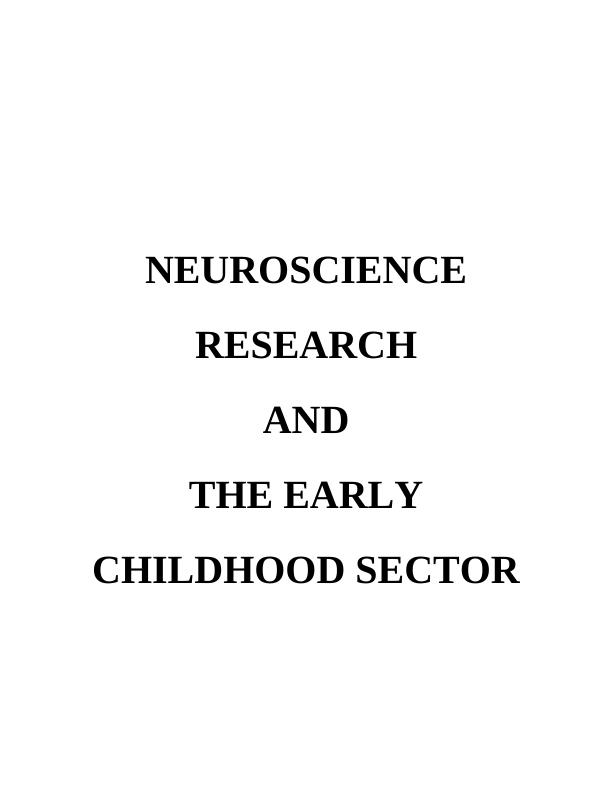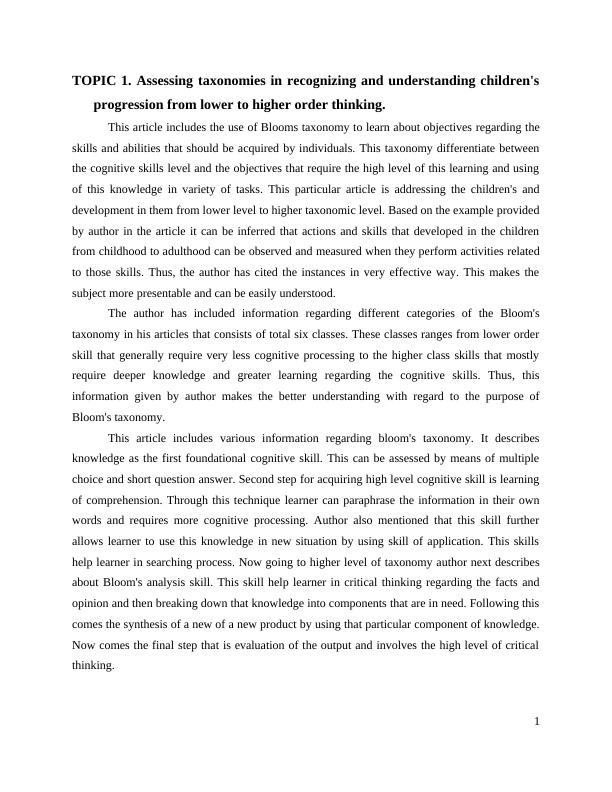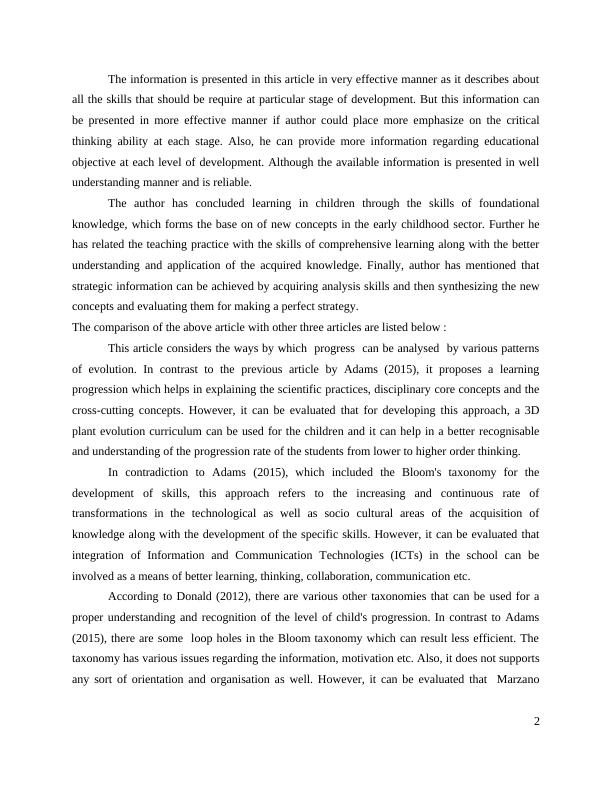Ask a question from expert
Neuroscience Research and Early Childhood Sector
12 Pages3392 Words371 Views
Added on 2020-06-03
Neuroscience Research and Early Childhood Sector
Added on 2020-06-03
BookmarkShareRelated Documents
NEUROSCIENCERESEARCHANDTHE EARLYCHILDHOOD SECTOR

TABLE OF CONTENTSTOPIC 1. Assessing taxonomies in recognizing and understanding children's progression fromlower to higher order thinking.........................................................................................................1TOPIC 2. Presenting neuroscientific research and executive functioning in the learningenvironment.....................................................................................................................................4TOPIC 3. Neuroscientific research and Self regulation in the learning environment. ...................7REFERENCES ...............................................................................................................................9

TOPIC 1. Assessing taxonomies in recognizing and understanding children'sprogression from lower to higher order thinking.This article includes the use of Blooms taxonomy to learn about objectives regarding theskills and abilities that should be acquired by individuals. This taxonomy differentiate betweenthe cognitive skills level and the objectives that require the high level of this learning and usingof this knowledge in variety of tasks. This particular article is addressing the children's anddevelopment in them from lower level to higher taxonomic level. Based on the example providedby author in the article it can be inferred that actions and skills that developed in the childrenfrom childhood to adulthood can be observed and measured when they perform activities relatedto those skills. Thus, the author has cited the instances in very effective way. This makes thesubject more presentable and can be easily understood.The author has included information regarding different categories of the Bloom'staxonomy in his articles that consists of total six classes. These classes ranges from lower orderskill that generally require very less cognitive processing to the higher class skills that mostlyrequire deeper knowledge and greater learning regarding the cognitive skills. Thus, thisinformation given by author makes the better understanding with regard to the purpose ofBloom's taxonomy. This article includes various information regarding bloom's taxonomy. It describesknowledge as the first foundational cognitive skill. This can be assessed by means of multiplechoice and short question answer. Second step for acquiring high level cognitive skill is learningof comprehension. Through this technique learner can paraphrase the information in their ownwords and requires more cognitive processing. Author also mentioned that this skill furtherallows learner to use this knowledge in new situation by using skill of application. This skillshelp learner in searching process. Now going to higher level of taxonomy author next describesabout Bloom's analysis skill. This skill help learner in critical thinking regarding the facts andopinion and then breaking down that knowledge into components that are in need. Following thiscomes the synthesis of a new of a new product by using that particular component of knowledge.Now comes the final step that is evaluation of the output and involves the high level of criticalthinking.1

The information is presented in this article in very effective manner as it describes aboutall the skills that should be require at particular stage of development. But this information canbe presented in more effective manner if author could place more emphasize on the criticalthinking ability at each stage. Also, he can provide more information regarding educationalobjective at each level of development. Although the available information is presented in wellunderstanding manner and is reliable.The author has concluded learning in children through the skills of foundationalknowledge, which forms the base on of new concepts in the early childhood sector. Further hehas related the teaching practice with the skills of comprehensive learning along with the betterunderstanding and application of the acquired knowledge. Finally, author has mentioned thatstrategic information can be achieved by acquiring analysis skills and then synthesizing the newconcepts and evaluating them for making a perfect strategy.The comparison of the above article with other three articles are listed below :This article considers the ways by which progress can be analysed by various patternsof evolution. In contrast to the previous article by Adams (2015), it proposes a learningprogression which helps in explaining the scientific practices, disciplinary core concepts and thecross-cutting concepts. However, it can be evaluated that for developing this approach, a 3Dplant evolution curriculum can be used for the children and it can help in a better recognisableand understanding of the progression rate of the students from lower to higher order thinking. In contradiction to Adams (2015), which included the Bloom's taxonomy for thedevelopment of skills, this approach refers to the increasing and continuous rate oftransformations in the technological as well as socio cultural areas of the acquisition ofknowledge along with the development of the specific skills. However, it can be evaluated thatintegration of Information and Communication Technologies (ICTs) in the school can beinvolved as a means of better learning, thinking, collaboration, communication etc. According to Donald (2012), there are various other taxonomies that can be used for aproper understanding and recognition of the level of child's progression. In contrast to Adams(2015), there are some loop holes in the Bloom taxonomy which can result less efficient. Thetaxonomy has various issues regarding the information, motivation etc. Also, it does not supportsany sort of orientation and organisation as well. However, it can be evaluated that Marzano2

End of preview
Want to access all the pages? Upload your documents or become a member.
Related Documents
The Application of Blooms Questioninglg...
|4
|854
|307
Teaching and Learning in Health Professionalslg...
|11
|2372
|163
Revised Bloom's Taxonomy: Dimensions of Knowledgelg...
|4
|552
|90
Theories, Principles, and Models of Learning and Communicationlg...
|22
|6217
|1
Early Childhood Education and Carelg...
|8
|2268
|94
Understanding the Learning Processlg...
|3
|1876
|2